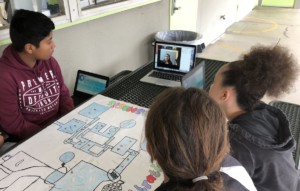8 Principles of Productive Gamification

Using games to promote learning isn’t a new idea. But the widespread use of game-based adaptive learning systems, the explosion of mobile learning applications, and the growing use of game-based strategies makes gamification one of the most important education trends of this decade.
According to Teachers College, gamification is the use of game mechanics and dynamics like badges, leaderboards, and actions to improve motivation and learning in informal and formal settings.
Ranging from occasional mobile game play, to scheduled weekly time in an adaptive system, to an entire school like Quest to Learn organized around gamification principles, it’s likely that games and/or gamification are part of the learning experience for most U.S. K-12 students.
While widespread use of digital learning games and game-based strategies is relatively new, 8 principles of productive gamification are emerging.
1. Conceptual Challenges. Good games incorporate rigorous pedagogy and engaging challenges that promote deeper conceptual learning rather than trivial fact recall. Good games are learning tasks–not entertainment interrupted by a learning quizzes.
Good games are aligned to widely respected standards making it easier to combine with other forms of instruction and assessment and ensure coverage of key concepts. “One of the exciting things that leaps out to me when reading the new Common Core State Standards for mathematics is that the spirit of inquiry and curiosity is back, hardwired into a document that will likely form the basis for mathematics teaching and learning for a long time,” said game developer Nigel Nisbet.
2. Productive Failure. Good games encourage supported failure with instructional feedback. Mental models take lots of practice and feedback to develop. Children learn by creating and testing hypotheses and receiving useful feedback.
3. Careful Calibration. Productive learning systems locate and maintain the zone of proximal development–the gap between what a student knows and what he or she can achieve. Good games are well calibrated–not so easy that they create boredom and not so difficult that they produce frustration.
4. Boosts Persistence. Dr. Jane McGonigal , author, researcher, and game proponent notes that the mindset of gaming–the willingness to fail and keep trying –boosts resilience, persistence, and in and of itself prepares students in the virtual world to deal better with real-world challenges.
Some teachers track team progress on big projects on an interactive whiteboard–an interesting combination of project management tools, a pacing guide, and the competitive effect of a leaderboard.
5. Builds Confidence. Elizabeth Corcoran, founder of Lucere organization devoted to helping educators find and use the most appropriate technology for inspiring students, notes that one of the main benefits of gamification is that it helps students gain confidence as they learn how to have a winning learning experience, and makes them hungry for tools that put them in control. Good games and game-based strategies build a sense of agency and efficacy.
6. Enhances Intrinsic Motivation. Gamification engages and motivates students while developing problem solving skills and a sense of accomplishment thanks to continuous feedback and rewards. Cristina Ioana Muntean notes that good games and game-based strategies don’t “replace the intrinsic motivation of student, which is stronger and more long term, with the extrinsic one, but offer a combination of the two for a better performance.”
7. Accessibility. In a good game, “every player having equal access to resources and information” and, while progress may vary, “there is a continual opportunity to learn skills to mastery at all levels,”according to teacher Dave Guymon. He added, “Like good game designers, teachers must structure the learning environment and process to offer equal access to the information and resources needed by our students to succeed in learning.”
8. Deeper Learning . “Some innovative game-based and adaptive learning programs embed key elements of performance assessment,” said Tim Hudson, Dreambox Learning. “These programs present students with new and unfamiliar situations that require them to engage in critical thinking and strategic problem solving to accomplish challenging and meaningful goals.”
Gamification is most common in mathematics about which Mike Flynn, director of Mathematics Leadership Programs at Mount Holyoke College said, “We must give our teachers and students room to explore the area of mathematics so that math is no longer about memorizing procedures, but about developing strong mathematical ideas and understandings that benefit students for life, not just one test.”
It’s the learning, suggests veteran game designer Raph Koster, is what our favorite games are all about–and we can learn a lot from them about improving education outcomes. Well constructed and applied, learning games and game-based strategies hold the potential to boost motivation, extent persistence, build automaticity, and deepen learning.
For more, stay tuned for a blended learning trends paper from DreamBox in March.
DreamBox and MIND Research Institute are Getting Smart Advocacy Partners.








0 Comments
Leave a Comment
Your email address will not be published. All fields are required.